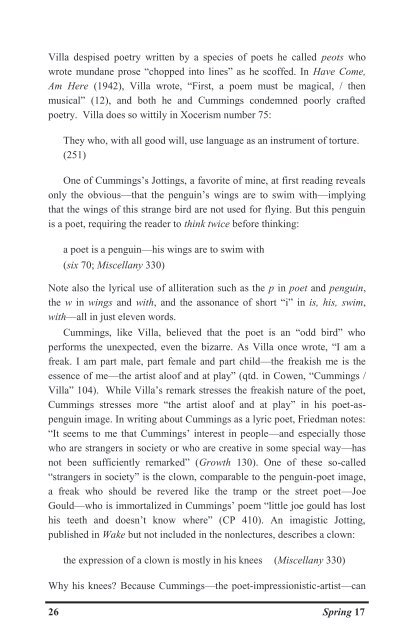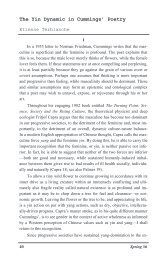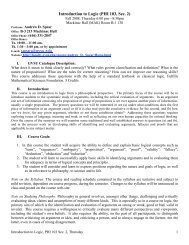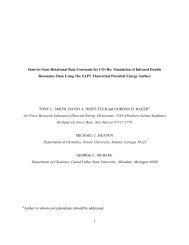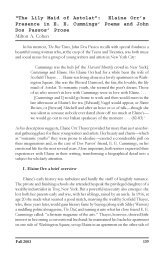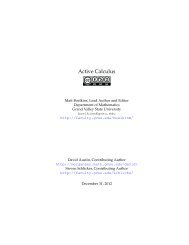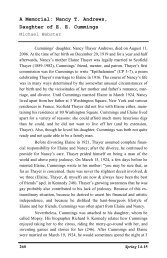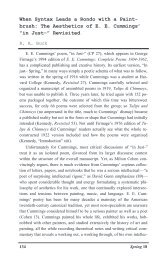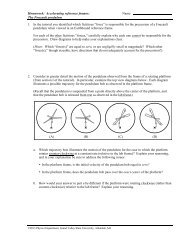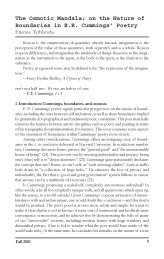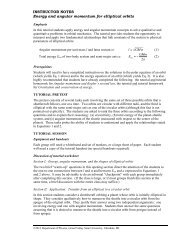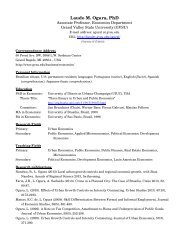E.E. Cummings' 'Jottings' and José Garcia Villa's 'Xocerisms ... - Gvsu
E.E. Cummings' 'Jottings' and José Garcia Villa's 'Xocerisms ... - Gvsu
E.E. Cummings' 'Jottings' and José Garcia Villa's 'Xocerisms ... - Gvsu
You also want an ePaper? Increase the reach of your titles
YUMPU automatically turns print PDFs into web optimized ePapers that Google loves.
Villa despised poetry written by a species of poets he called peots whowrote mundane prose “chopped into lines” as he scoffed. In Have Come,Am Here (1942), Villa wrote, “First, a poem must be magical, / thenmusical” (12), <strong>and</strong> both he <strong>and</strong> Cummings condemned poorly craftedpoetry. Villa does so wittily in Xocerism number 75:They who, with all good will, use language as an instrument of torture.(251)One of Cummings’s Jottings, a favorite of mine, at first reading revealsonly the obvious—that the penguin’s wings are to swim with—implyingthat the wings of this strange bird are not used for flying. But this penguinis a poet, requiring the reader to think twice before thinking:a poet is a penguin—his wings are to swim with(six 70; Miscellany 330)Note also the lyrical use of alliteration such as the p in poet <strong>and</strong> penguin,the w in wings <strong>and</strong> with, <strong>and</strong> the assonance of short “i” in is, his, swim,with—all in just eleven words.Cummings, like Villa, believed that the poet is an “odd bird” whoperforms the unexpected, even the bizarre. As Villa once wrote, “I am afreak. I am part male, part female <strong>and</strong> part child—the freakish me is theessence of me—the artist aloof <strong>and</strong> at play” (qtd. in Cowen, “Cummings /Villa” 104). While Villa’s remark stresses the freakish nature of the poet,Cummings stresses more “the artist aloof <strong>and</strong> at play” in his poet-aspenguinimage. In writing about Cummings as a lyric poet, Friedman notes:“It seems to me that Cummings’ interest in people—<strong>and</strong> especially thosewho are strangers in society or who are creative in some special way—hasnot been sufficiently remarked” (Growth 130). One of these so-called“strangers in society” is the clown, comparable to the penguin-poet image,a freak who should be revered like the tramp or the street poet—JoeGould—who is immortalized in Cummings’ poem “little joe gould has losthis teeth <strong>and</strong> doesn’t know where” (CP 410). An imagistic Jotting,published in Wake but not included in the nonlectures, describes a clown:the expression of a clown is mostly in his knees (Miscellany 330)Why his knees? Because Cummings—the poet-impressionistic-artist—can26 Spring 17


